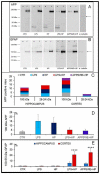Modulation of LPS-Induced Neurodegeneration by Intestinal Helminth Infection in Ageing Mice
- PMID: 37762297
- PMCID: PMC10530578
- DOI: 10.3390/ijms241813994
Modulation of LPS-Induced Neurodegeneration by Intestinal Helminth Infection in Ageing Mice
Abstract
Parasitic helminths induce a transient, short-term inflammation at the beginning of infection, but in persistent infection may suppress the systemic immune response by enhancing the activity of regulatory M2 macrophages. The aim of the study was to determine how nematode infection affects age-related neuroinflammation, especially macrophages in the nervous tissue. Here, intraperitoneal LPS-induced systemic inflammation resulting in brain neurodegeneration was enhanced by prolonged Heligmosomoides polygyrus infection in C57BL/6 mice. The changes in the brain coincided with the increase in M1 macrophages, reduced survivin level, enhanced APP and GFAP expression, chitin-like chains deposition in the brain and deterioration behaviour manifestations. These changes were also observed in transgenic C57BL/6 mice predisposed to develop neurodegeneration typical for Alzheimer's disease in response to pathogenic stimuli. Interestingly, in mice infected with the nematode only, the greater M2 macrophage population resulted in better results in the forced swim test. Given the growing burden of neurodegenerative diseases, understanding such interactive associations can have significant implications for ageing health strategies and disease monitoring.
Keywords: ageing; helminths; immunomodulation; neurobehavioural manifestations; neurodegenerative diseases; neuroinflammation; persistent infection.
Conflict of interest statement
The authors declare that the research was conducted in the absence of any commercial or financial relationships that could be construed as a potential conflict of interest.
Figures







Similar articles
-
Adoptive transfer of Trichinella spiralis-activated macrophages can ameliorate both Th1- and Th2-activated inflammation in murine models.Sci Rep. 2019 Apr 25;9(1):6547. doi: 10.1038/s41598-019-43057-1. Sci Rep. 2019. PMID: 31024043 Free PMC article.
-
Neuronal impairment following chronic Toxoplasma gondii infection is aggravated by intestinal nematode challenge in an IFN-γ-dependent manner.J Neuroinflammation. 2019 Jul 29;16(1):159. doi: 10.1186/s12974-019-1539-8. J Neuroinflammation. 2019. PMID: 31352901 Free PMC article.
-
Helminth infection protects against high fat diet-induced obesity via induction of alternatively activated macrophages.Sci Rep. 2018 Mar 15;8(1):4607. doi: 10.1038/s41598-018-22920-7. Sci Rep. 2018. PMID: 29545532 Free PMC article.
-
[Nematode infections in mice--an experimental model of immunoregulation].Wiad Parazytol. 2009;55(2):157-66. Wiad Parazytol. 2009. PMID: 19670531 Review. Polish.
-
Gut Microbiota Interact With the Brain Through Systemic Chronic Inflammation: Implications on Neuroinflammation, Neurodegeneration, and Aging.Front Immunol. 2022 Apr 7;13:796288. doi: 10.3389/fimmu.2022.796288. eCollection 2022. Front Immunol. 2022. PMID: 35464431 Free PMC article. Review.
References
-
- Battaglia S., Di Fazio C., Vicario C.M., Avenanti A. Neuropharmacological Modulation of N-methyl-D-aspartate, Noradrenaline and Endocannabinoid Receptors in Fear Extinction Learning: Synaptic Transmission and Plasticity. Int. J. Mol. Sci. 2023;24:5926. doi: 10.3390/ijms24065926. - DOI - PMC - PubMed
MeSH terms
Substances
Supplementary concepts
Grants and funding
LinkOut - more resources
Full Text Sources
Medical
Miscellaneous

